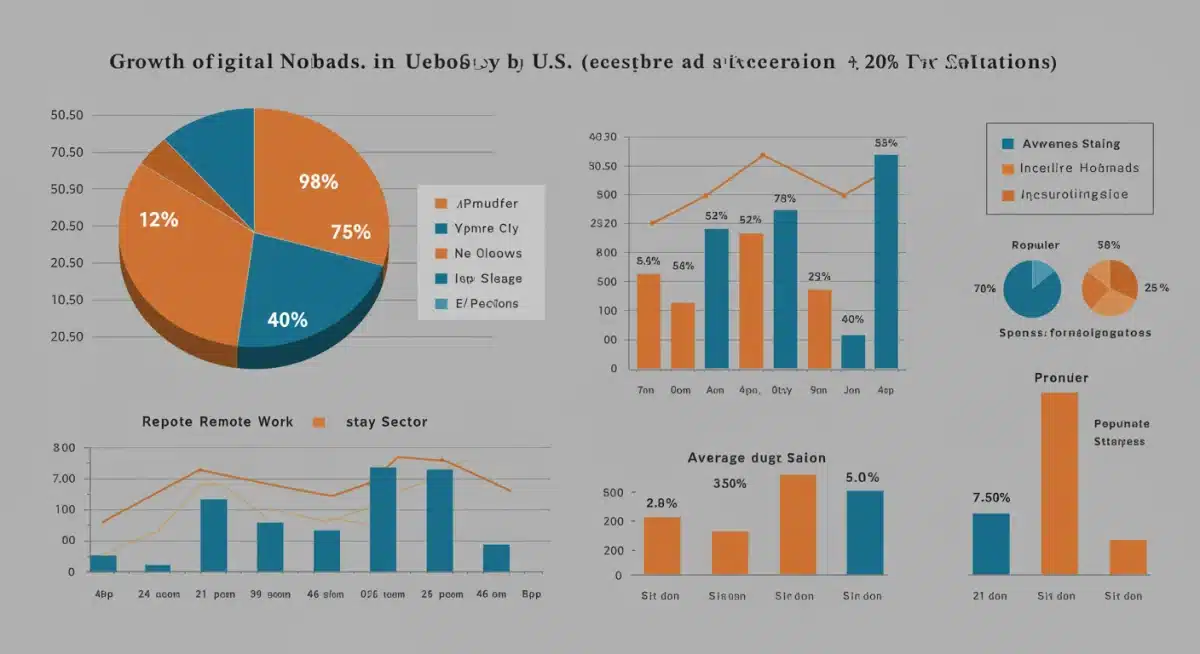Market Analysis: Digital Nomads Boost US Long-Term Travel 2025

Market analysis forecasts show that digital nomads are profoundly reshaping the U.S. long-term stay travel sector for 2025, driving significant demand for flexible, amenity-rich accommodations across diverse regions.
Recent data indicates a significant shift in the U.S. travel landscape, with a new market analysis highlighting the growing influence of digital nomad long-term travel in 2025. This evolving demographic is not just a trend but a powerful force redefining accommodation needs and local economies.
The Surge of Digital Nomads: A 2025 Overview
As of late 2024, the United States is witnessing an unprecedented surge in its digital nomad population, a trend poised to profoundly impact the long-term stay travel market in 2025. This group, characterized by location-independent professionals, is increasingly choosing extended stays, moving beyond traditional tourism models. Recent reports from MBO Partners indicate that the number of American digital nomads has more than doubled since 2019, reaching nearly 17 million in 2023, with projections for continued robust growth into the next year.
This demographic shift is forcing the hospitality and real estate sectors to rapidly adapt. Traditional hotels and short-term rentals are now competing with specialized co-living spaces and extended-stay properties, all vying for this lucrative segment. The economic implications are vast, affecting everything from local housing markets to the demand for diverse services and infrastructure in popular nomad destinations.
Defining the Digital Nomad Demographic
Understanding who these travelers are is crucial. They are not merely vacationers; they are working professionals seeking a blend of work-life balance, cultural immersion, and cost-effectiveness. Their travel patterns are less about quick getaways and more about establishing temporary roots, often for several months at a time.
- Age Range: Predominantly Millennials and Gen Z, but also a growing segment of older professionals.
- Income Levels: Varied, but generally stable, allowing for sustained travel and living expenses.
- Occupations: Tech, marketing, consulting, creative arts, and various online services.
- Motivations: Flexibility, cultural experience, cost of living arbitrage, and adventure.
Economic Impact on U.S. Long-Term Stay Markets
The economic footprint of digital nomads on the U.S. long-term stay market is becoming increasingly significant. Unlike tourists who spend heavily for short periods, nomads contribute consistently over extended durations, impacting local economies in a more sustained manner. This includes spending on rent, groceries, local services, and entertainment, often integrating into the community fabric.
Cities and towns that were once considered secondary markets are now experiencing revitalized economic activity due to the influx of remote workers. This phenomenon is particularly noticeable in areas with lower costs of living, strong internet infrastructure, and appealing natural or cultural attractions. The demand for furnished apartments, flexible leases, and co-working spaces is soaring, creating new revenue streams for property owners and service providers.
Key Economic Indicators
Analysis of 2024 data reveals several key indicators pointing to this trend’s growing economic power:
- Increased Rental Demand: A steady rise in inquiries for monthly and multi-month rentals.
- Local Business Support: Higher patronage for local cafes, restaurants, and small businesses.
- Service Sector Growth: Expansion in services catering to remote workers, such as specialized co-working facilities and community events.
Evolving Accommodation Preferences
The preferences of digital nomads are distinct, driving innovation in the accommodation sector. They seek more than just a place to sleep; they require spaces that facilitate both work and leisure, often with a strong emphasis on community and convenience. This has led to the rise of purpose-built co-living spaces, extended-stay hotels with enhanced amenities, and a re-evaluation of traditional rental properties.
Flexible booking options are paramount, as nomads often adjust their plans based on projects, personal interests, or seasonal changes. High-speed internet, dedicated workspaces, and access to communal areas are non-negotiable features. Property managers and developers are responding by integrating these elements into their offerings, understanding that a one-size-fits-all approach no longer suffices for this dynamic market segment.
What Nomads Look For
Beyond basic necessities, digital nomads prioritize specific attributes in their long-term accommodations:
- Reliable High-Speed Internet: Essential for remote work; a deal-breaker if inadequate.
- Dedicated Workspace: A quiet area or desk setup for productivity.
- Community and Networking Opportunities: Access to events or shared spaces to connect with like-minded individuals.
- Wellness Facilities: Gyms, yoga studios, or access to outdoor activities.
- Convenient Location: Proximity to amenities, public transport, and cultural sites.
Geographic Hotspots and Emerging Destinations
While traditional tourist hubs like New York City and Los Angeles still attract digital nomads, a significant trend for 2025 is the diversification of preferred destinations. Mid-sized cities, often lauded for their lower cost of living and vibrant local cultures, are rapidly gaining popularity. Austin, Texas; Denver, Colorado; and Asheville, North Carolina, are examples of cities that have actively courted this demographic, recognizing its economic potential.
Coastal towns, mountain communities, and even some rural areas with robust internet infrastructure are also emerging as attractive options. The desire for a balanced lifestyle, away from urban congestion, is a driving factor. Local governments and tourism boards are increasingly implementing initiatives to attract and retain digital nomads, from specialized visa programs to community-building events.

Challenges and Opportunities for Stakeholders
The rise of digital nomad long-term travel presents both challenges and significant opportunities for various stakeholders. For the hospitality industry, the opportunity lies in innovating service models and property types to meet unique demands. This includes offering flexible lease terms, integrating co-working spaces, and fostering community among guests. However, it also means competing with traditional residential markets and navigating zoning regulations.
Local communities face the challenge of managing increased demand for housing and resources, which can sometimes lead to gentrification or strain on existing infrastructure. Conversely, the influx of skilled professionals and sustained economic activity offers opportunities for cultural enrichment, diversified local economies, and increased tax revenues. Urban planners and policymakers are tasked with finding a balance that benefits both newcomers and long-term residents.
Addressing Key Issues
Effective strategies are required to maximize benefits while mitigating potential downsides:
- Infrastructure Development: Investing in robust internet and public transport.
- Affordable Housing Initiatives: Ensuring housing remains accessible for all residents.
- Community Integration Programs: Facilitating interaction between nomads and locals.
- Regulatory Frameworks: Adapting zoning and taxation to accommodate new living and working models.
The Future of Long-Term Stay Travel: 2025 and Beyond
Looking ahead to 2025 and beyond, the influence of digital nomads on U.S. long-term stay travel is only expected to deepen. The remote work paradigm, solidified during the pandemic, shows no signs of receding, suggesting a sustained and growing market for location-independent professionals. This will continue to drive innovation in housing, technology, and community services. Real estate developers, hoteliers, and local governments must remain agile and forward-thinking to capitalize on this evolving landscape.
The industry will likely see further specialization, with more niche offerings catering to specific types of digital nomads, such as families, retirees, or those with particular professional needs. Data analytics will play an increasingly vital role in understanding preferences and predicting future trends, allowing stakeholders to anticipate demand and tailor their services accordingly. The interconnectedness of work and travel will continue to blur, making the U.S. a prime destination for this dynamic global workforce.
| Key Point | Brief Description |
|---|---|
| Nomad Population Growth | U.S. digital nomad numbers have doubled since 2019, projected to grow significantly into 2025, impacting travel. |
| Economic Redefinition | Nomads provide sustained economic contributions to local economies through long-term spending, revitalizing diverse regions. |
| Accommodation Shifts | Demand for flexible, amenity-rich co-living and extended-stay options is rising, pushing hospitality innovation. |
| Emerging Hotspots | Mid-sized cities and non-traditional locales are becoming popular, driven by cost of living and lifestyle preferences. |
Frequently Asked Questions About Digital Nomads in U.S. Travel
The primary drivers are the widespread adoption of remote work, increased flexibility offered by employers, and a desire for improved work-life balance. Technological advancements and a growing awareness of the digital nomad lifestyle also contribute significantly to this expansion.
Digital nomads provide sustained economic contributions through long-term spending on housing, groceries, local services, and entertainment. This consistent patronage helps revitalize local businesses and diversify the economic base of communities, often in non-traditional tourist areas.
Digital nomads prefer accommodations offering flexibility, high-speed internet, dedicated workspaces, and community features. Co-living spaces, extended-stay hotels, and furnished apartments with flexible lease terms are particularly popular choices that meet these specific needs.
While major cities remain attractive, mid-sized cities like Austin, Denver, and Asheville are gaining popularity due to lower costs of living, vibrant cultural scenes, and strong community appeal. Coastal towns and mountain regions with good infrastructure are also emerging destinations.
Challenges include potential strains on local resources, increased housing demand leading to gentrification, and the need for upgraded infrastructure. Communities must balance attracting nomads with ensuring sustainable growth and maintaining affordability for long-term residents.
What Happens Next
The continued growth of digital nomad long-term travel in the U.S. signifies a fundamental shift in how people live and work. Stakeholders across the hospitality, real estate, and government sectors must prioritize adaptive strategies, focusing on flexible infrastructure and community integration. Expect to see more tailored services and policies emerging in 2025, as cities vie to attract this economically impactful demographic while addressing the evolving needs of their existing populations. The market is dynamic, and continuous monitoring of trends will be crucial for success.